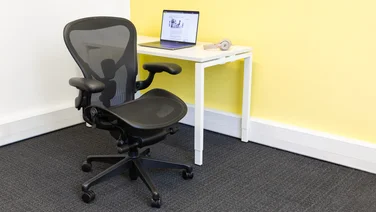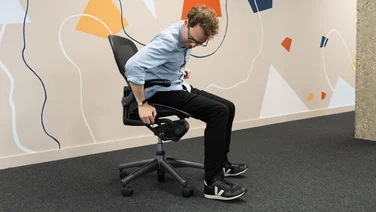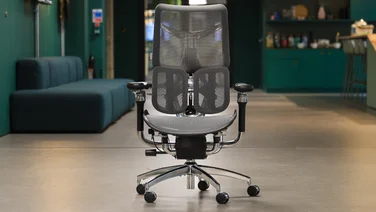To help us provide you with free impartial advice, we may earn a commission if you buy through links on our site. Learn more

It’s an unwelcome workplace scenario – you attempt to adjust your office chair and nothing happens. That side lever is hopelessly inept, and your chair doesn’t rise up as it should. Even worse – every time you sit down, it involuntarily makes a slow and graceless descent towards the ground.
What might cause your chair to sink?
The most likely cause of a sinking office chair is a damaged pneumatic cylinder. Almost all office chairs with adjustable heights are powered by a pneumatic or compressed gas cylinder plus a piston, which use pressure to force the gas through a chamber and move the piston. This cylinder is what allows the chair’s height to be increased or decreased.
Unfortunately, as the pressure in the piston mechanism becomes weaker over time, nitrogen can leak out and the chair can continually sink as a result. If the seal becomes too damaged to maintain pressure, the cylinder has effectively failed and the chair will be unable to support anyone’s weight and sinks to the ground.
Thankfully, there are a few other reasons your chair might be intent on taking a downward trajectory, which we’ve outlined below, as well as some quick (temporary) fixes if your cylinder is damaged. In that case, it may be time for a new one. If so, have a look at our pick of the best office chairs you can buy.
READ NEXT: Best office chairs
Check the pneumatic cylinder
First, look for any signs of wear or deterioration in the cylinder, and ensure it’s not leaking or damaged. It’s important to note that you can’t actually repair a damaged cylinder by yourself, but replacing it with a new one is an option: there are various sizes available, so you’ll need to ensure you choose a cylinder with the right diameter and top cap to match your setup.However, as buying a replacement cylinder is often almost as expensive as a new chair, here are two temporary DIY solutions you can try in the meantime…
Use a hose clamp and duct tape – If there’s a plastic cover over the cylinder, remove it to reveal the metal part underneath. Once you’ve adjusted the chair to your desired height (as this can’t be altered later), wrap a few layers of duct tape around the cylinder to provide better grip. Then wrap your hose clamp around the top of the cylinder, tighten it as much as possible and fasten it with the screw. This should stop the sinking problem and keep your seat in place for a while at least.
Use PVC pipe – Cut a length of PVC pipe to the same length as the chair’s cylinder, and check it’s just a little wider in diameter. Cut a vertical line into the pipe on one side only, so you can slip it over the cylinder. This should be sufficient to hold the weight of the chair base and stop it sinking.
Please bear in mind that these options aren’t a proper repair or permanent fix – but they will give you some leeway to find a more permanent solution.
READ NEXT: How to stop an office chair squeaking
Tighten all the screws and bolts
Loose screws and bolts can also contribute to “sinking chair syndrome”, and are a much easier problem to tackle. Turn your chair upside down so you can easily inspect all the moving parts, then use a screwdriver or Allen key to tighten anything loose. Bingo, problem sorted.
Adjust the tension control knob
Many office chairs come with a tension control knob that allows you to adjust the resistance of the reclining mechanism, and this can loosen over time. Simply increase the tension to provide more support and this will also help to prevent the chair from sinking too easily.
How to avoid “sinking chair syndrome” in the future
Research a good quality chair with a decent warranty – When you’re spending a large proportion of your day in a chair sitting at a desk, you don’t really want to scrimp on quality – and like many things, with office chairs if you buy cheap you buy twice.
We’re big fans of this advice from DBI Furniture Solutions’ managing director Nick Pollitt, who tells us the best way to prevent an office chair from sinking is not to buy a cheap product in the first place. He says, if possible, you should invest in a quality office chair with a minimum five year manufacturer’s guarantee, so any problems it may develop are covered by a warranty.
Avoid overloading your chair – Exceeding your chair’s weight capacity can put excessive strain on the components and cause it to sink. Similarly, sitting on the seat too abruptly can create a sudden “overload force” and produce similar damage. As such, it’s important to use the chair within its specified weight limit to prevent damage and maintain its integrity.
Perform regular maintenance checks – You can also avoid another sinking scenario by giving your chair regular checks at least a few times each year. Doing so might highlight a leaking cylinder or loose screws and bolts that need to be tightened.





